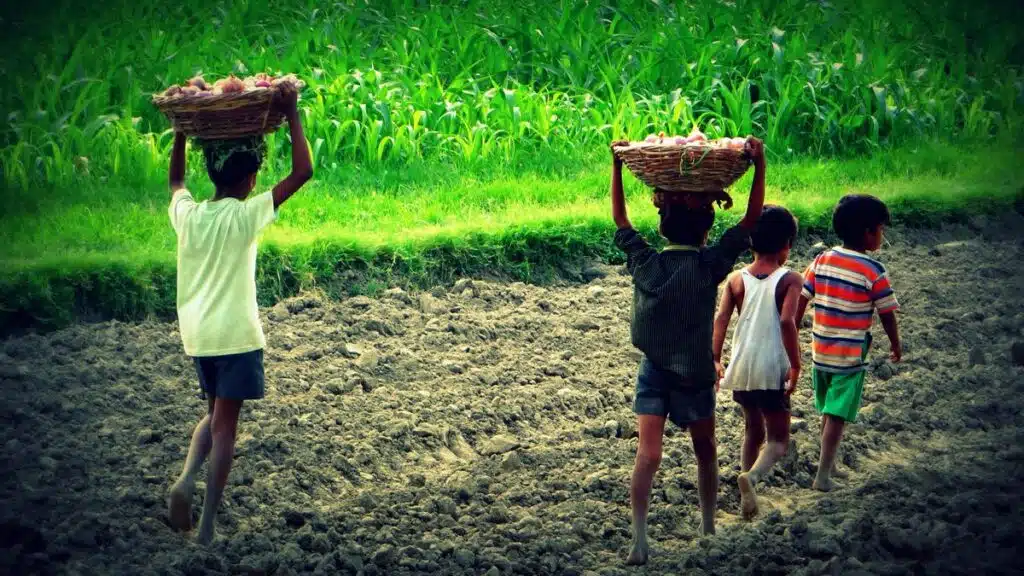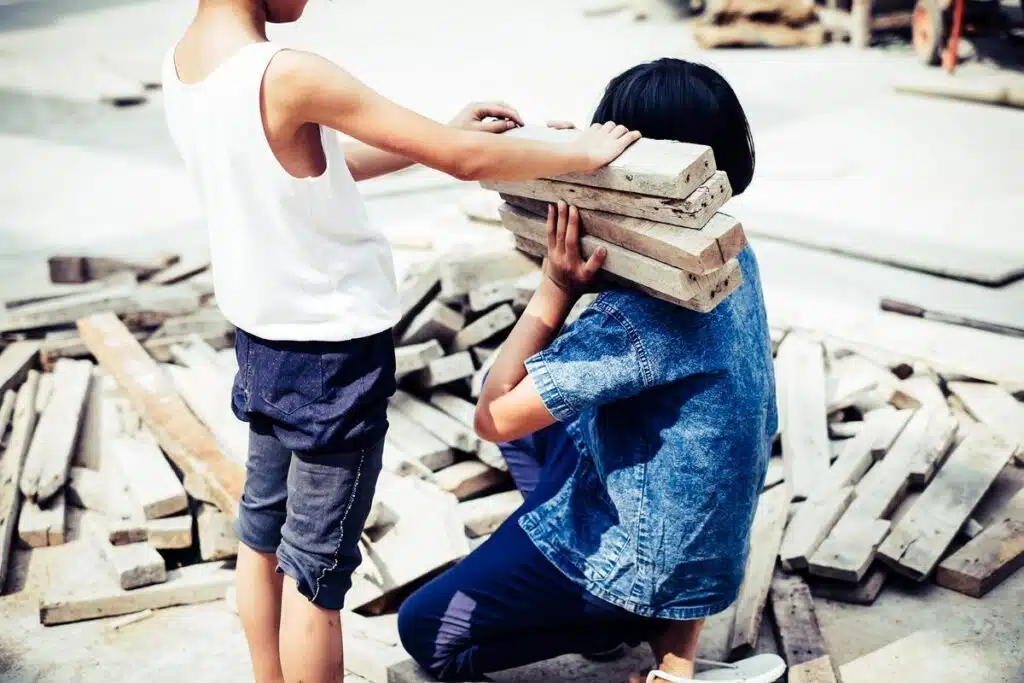
In this Article on Child Labour, we delve into an era where childhood memories and child development are paramount. It’s disheartening to witness children being deprived of their innocent years, forced into labor in factories, fields, and homes. Following is the collection of short at long paragraph on child labour for all Classes. This collection of Article on Child Labour is suitable for all age group students.
Article on Child Labour 100 Words
Child labour is a serious problem in many parts of the world. It occurs when children are forced to work in hazardous conditions, often for long hours and for little or no pay. This can have a negative impact on their health, education, and overall well-being. Child labour often prevents children from attending school, which can limit their future opportunities.
In some cases, it can also lead to dangerous and unhealthy working conditions. No child should have to work in dangerous, unhealthy or exploitative conditions. Unfortunately, this is the reality for millions of children around the world who are forced to work in factories, fields and homes instead of attending school and playing with friends.

Article on Child Labour 150 Words
Child labour is a serious problem in many parts of the world. Children are forced to work long hours in dangerous and unhealthy conditions. They are often paid very little, if anything at all. This makes it very hard for them to break out of the cycle of poverty. Child labour needs to be stopped so that children can have a chance at a better future. In conclusion, it is evident that child labour is still a huge problem in many parts of the world.
Despite the efforts of organisations and governments to tackle the issue, much more needs to be done to eradicate this terrible practice. Education is key in this fight, as children need to be made aware of their rights and given the opportunity to lead better lives. With everyone working together, it is possible to end child labour for good.
Article on Child Labour 200 Words
There are many children around the world who are forced to work instead of going to school. This is called child labour. Some children work in factories, others in fields, and some even in homes as domestic servants. Child labour is dangerous and often results in injuries or death. It can also lead to children being trafficked and sold into slavery. Children who work are often deprived of their childhood and miss out on an education.
This keeps them trapped in a cycle of poverty. Child labour must be stopped so that all children can have a bright future. It is heart-wrenching to think about the millions of children around the world who are forced to work in dangerous and unhealthy conditions. We hope that this article has helped raise awareness about the issue of child labour and what we can do to help put an end to it.
With your support, we can make a difference in the lives of these children and give them a chance at a better future. Thank you for your time and consideration. In this article, we’ve looked at some of the reasons why children are forced into labor, as well as some of the ways that it can impact their lives. It’s clear that child labor is a complex issue, but there are things that we can do to help those who are affected by it.

Article on Child Labour 300 Words
Child labour is a global problem that affects millions of children around the world. While there are many causes of child labour, some of the most common include poverty, lack of access to education, and family obligations. Child labour can have a negative impact on a child’s health, education, and overall development, so it is important to work to prevent it. You can do your part by supporting organizations that work to end child labour and by raising awareness about the issue. Thank you for taking the time to learn more about this important topic.
There are many causes of child labour. One of the most common is poverty. Families who are struggling to make ends meet may see child labour as a way to bring in additional income. Sometimes, children are forced to work by adults who take advantage of their situation.
Other times, they may be lured into dangerous work situations with the promise of good pay. Whatever the cause, child labour is a serious problem that often leads to exploitation and abuse. There are many reasons why children are forced into child labour. In some cases, it is due to poverty. Families may see child labour as a way to make some extra money to help make ends meet. In other cases, it may be due to cultural factors.
In some cultures, it is seen as acceptable for children to work, even if they are very young. Sometimes, children are forced into labour because of trafficking or other forms of exploitation. Unfortunately, these are just some of the reasons why child labour continues to be a problem in many parts of the world.
In conclusion, there are many factors that contribute to the prevalence of child labour. Poverty is often the root cause, as families struggling to make ends meet may see no other option than to send their children out to work. Lack of access to education can also play a role, as children who are not in school are more likely to end up in labour jobs.
Article on Child Labour 400 + Words
Introduction: The Stolen Joys of Childhood
It’s hard to imagine that in this day and age, there are still children being forced to work in factories, fields, and homes. But it’s a harsh reality for millions of kids around the world. In this article, we will explore the problem of child labour and what can be done to fight it. From the industries where it’s most prevalent to the countries where laws are lax, we will shine a light on this global issue. Read on to learn more and see what you can do to help.
Child Labour: A Barrier to Healthy Childhood Development
Child labour is defined as work that is harmful to children or interferes with their schooling. It can take many forms, including working in hazardous conditions, doing heavy manual labour, or being involved in the worst forms of child labour such as forced marriage, trafficking, and sexual exploitation.
Globally, it is estimated that 168 million children are in child labour, with 85 million of them in its worst forms. Sub-Saharan Africa and Asia continue to have the highest number of child labourers. Of all regions, sub-Saharan Africa has the highest incidence of child labour, with one in four children engaged in child labour.
There are many factors that contribute to the prevalence of child labour. Poverty is the main driver of child labour as families rely on their children’s income to survive. Lack of access to quality education and limited job opportunities also play a role. In some cases, cultural norms and traditions condone child labour while conflict increases the likelihood of children being recruited into armed groups.
Child labourers often work long hours in dangerous conditions for little or no pay. This can have a profound impact on their physical and mental health, as well as their education and future prospects.
Forms of Child Labour: Threatening Childhood Memories
The forms of child labour vary depending on the type of work being done, as well as the age and gender of the child. Some of the more common forms include:
1. Agriculture: Children working in fields, plantations or livestock farms.
2. Manufacturing: Children working in factories, workshops or sweatshops.
3. Retail: Children working in shops, stalls or hawking goods on the street.
4. Domestic work: Children working as maids, cooks or nannies in private homes.
5. Begging: Children begging for money or food on the streets.
6. Prostitution: Children forced to engage in sexual activity for money or goods.
The Effects of Child Labour on Children
The effects of child labor on children are manifold. They may experience physical injuries and health problems as a result of their work, and may also suffer from emotional and psychological trauma.
Children who work in hazardous conditions or in jobs that are physically demanding may experience musculoskeletal problems, respiratory ailments, and skin diseases. They are also at increased risk of accidents and injury.
Child laborers often work long hours for little pay, in difficult and dangerous conditions. This can lead to extreme fatigue, which can impact their health and well-being.
In addition to the physical dangers of child labor, children may also suffer from emotional and psychological trauma. This can include feelings of anxiety, stress, and depression. Children may also experience social isolation and feelings of worthlessness.
Underlying Causes: Factors Robbing Children of Carefree Childhoods
There are many causes of child labour. Some of the main ones are:
- Poverty: Families who live in poverty often see child labour as a way to make some extra money. In many cases, children are paid less than adults for doing the same work.
- Lack of education: Children who do not go to school are more likely to be involved in child labour. This is because they have less opportunity to learn about their rights and more likely to be exploited by adults.
- Conflict: In areas of conflict, children are often used as soldiers or forced to work in support roles such as cooking and cleaning. They may also be used in illegal activities such as drug smuggling and human trafficking.
- Natural disasters: After a natural disaster, such as an earthquake or tsunami, families may send their children to work in order to help rebuild their homes and livelihoods.
Towards a Nurtured Future: Solutions to Safeguard Child Development and Care
When it comes to finding solutions to the problem of child labour, there are a number of different approaches that can be taken. Some of the most common solutions include:
1. Education: One of the most effective ways to combat child labour is to ensure that all children have access to education. When children are in school, they are not working and they are also learning skills that will help them in future jobs.
2. Economic Development: Another way to reduce child labour is to promote economic development in countries where it is prevalent. When families have more money, they are less likely to send their children out to work. Furthermore, economic development can create jobs for adults which takes away the need for children to work.
3. Regulation: Governments can also help reduce child labour by passing laws and regulations that prohibit it. By making it illegal for businesses to hire children, fewer children will be working overall.
4. Enforcement: Of course, simply passing laws is not enough – they must also be enforced in order for them to be effective. Child labour inspection agencies can play a key role in this process by ensuring that businesses are complying with the law and penalizing those who are not.
Reclaiming Childhood: A Vision for a Brighter, Cared-for Future
Although child labour is still a problem in many parts of the world, it is encouraging to see that progress is being made to eradicate it. With more awareness and stricter laws in place, hopefully we will see an end to child labour in the near future. In the meantime, we must continue to support organisations that are working to help children affected by this issue and do what we can to prevent it from happening.